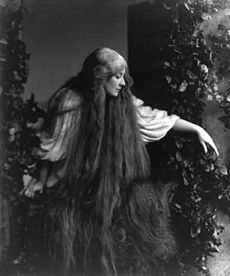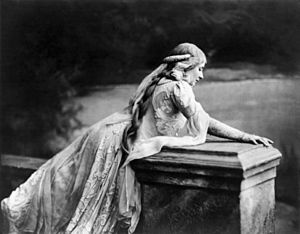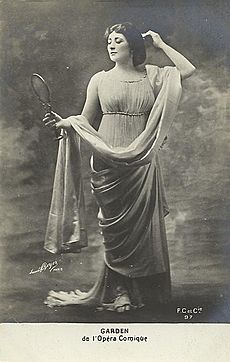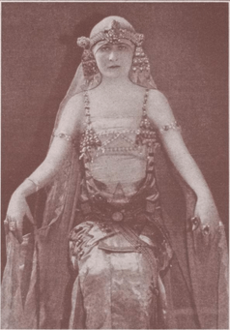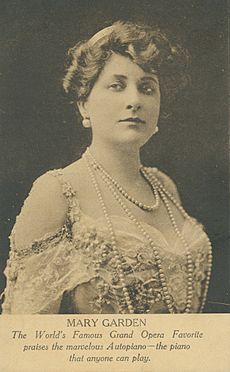Mary Garden facts for kids
Quick facts for kids
Mary Garden
|
|
|---|---|
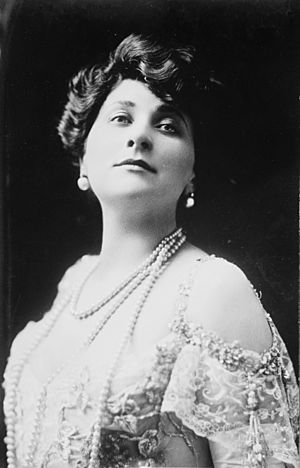
Mary Garden
|
|
| Born | 20 February 1874 Aberdeen, Scotland
|
| Died | 3 January 1967 (aged 92) House of Daviot, Inverurie, Scotland
|
| Citizenship | British American |
| Education | St Margaret's School for Girls, Aberdeen |
| Occupation | opera singer actress |
| Known for | creating the leading role in Claude Debussy's Pelléas et Mélisande (1902) and for her collaboration with the composer |
Mary Garden (born February 20, 1874 – died January 3, 1967) was a famous Scottish-American opera singer. She was known for her beautiful voice and amazing acting skills. Mary Garden had a long career in both France and America during the early 1900s.
People called her "the Sarah Bernhardt of opera" because she was such a great actress. She was especially good at using her voice in different ways to show feelings. Mary Garden had a lovely voice that could sing many notes, from high to low.
She became very successful in Paris in the early 1900s. She was the main soprano singer at the Opéra-Comique. She even performed in the first shows of several new operas. One of her most famous roles was Mélisande in Claude Debussy's Pelléas et Mélisande in 1902. She also worked closely with composer Jules Massenet, who wrote the main role in his opera Chérubin (1905) just for her.
In 1907, Oscar Hammerstein invited Mary Garden to sing in New York at the Manhattan Opera House. She quickly became a big star in America. By 1910, many people knew her name. She sang in operas in major American cities, including Boston and Philadelphia.
From 1910 to 1932, Mary Garden worked with several opera companies in Chicago. She even became the director of the Chicago Opera Association in 1921. As director, she helped put on the first show of Sergei Prokofiev's The Love for Three Oranges. She later sang with the Chicago Civic Opera until 1931.
Mary Garden also appeared in two silent films. After she stopped singing opera in 1934, she looked for new talent for MGM, a movie studio. She also gave talks about Claude Debussy's music until 1949. She wrote a successful book about her life called Mary Garden's Story in 1951.
You can still hear her voice today on many old recordings. She made these recordings between 1903 and 1929.
Contents
Mary Garden's Life Story
Early Years and Becoming a Star in Europe
Childhood and Moving to America
Mary Garden was born in Aberdeen, Scotland, on February 20, 1874. She was the oldest of four daughters. Her father, Robert Davidson Garden, worked as a cashier.
When she was nine years old, her family moved to Chicopee, Massachusetts, in the United States. A few years later, they moved to Hartford, Connecticut. Then, in 1888, when Mary was 14, they moved to Chicago.
Learning to Sing
Mary showed a lot of talent as a singer when she was young. She studied music in Chicago with Sarah Robinson-Duff. Wealthy friends, David and Florence Mayer, helped pay for her lessons.
In 1896, she went to Paris, France, to study singing even more. She learned from teachers like Trabadelo and Lucien Fugère. She also had some lessons with Sibyl Sanderson, an American soprano. Sibyl Sanderson introduced Mary to famous people like composer Jules Massenet and Albert Carré, who directed the Opéra-Comique.
First Opera Performance
Albert Carré was very impressed with Mary Garden's voice. He invited her to join the Opéra-Comique in 1900. Mary made her first professional opera appearance on April 10, 1900. She sang the main role in Gustave Charpentier's Louise. This was a surprise debut because she filled in at the last minute for another singer who was sick.
After this first performance, Mary Garden quickly became one of the top singers at the Opéra-Comique. In 1901, she performed in the first shows of two new operas. She also sang the main role in Massenet's Thaïs. In 1902, Claude Debussy chose her to play the main female role in the first Opéra-Comique performance of his opera Pelléas et Mélisande. Her performances were highly praised by critics. She also caused a stir as Salomé in the French version of Richard Strauss's opera.
After the success of Pelléas et Mélisande, Mary Garden sometimes sang in London at the Royal Opera House, Covent Garden. But she still performed often in Paris. She didn't really like London, so she decided not to take many more jobs there.
Her performances in Paris included roles in operas like Massenet's Grisélidis (1902) and Verdi's La traviata (1903). In 1905, she sang at the Opéra de Monte-Carlo in the first performance of Massenet's Chérubin. The composer wrote this role especially for her.
Moving to the United States and Later Career
Oscar Hammerstein I convinced Mary Garden to come to New York City. She left her regular performances at the Opéra-Comique to join the Manhattan Opera House. She made her American debut on November 25, 1907, in the main role of Thaïs. This role was perfect for her. She also amazed American audiences with her performance as a young boy in Massenet's Le jongleur de Notre-Dame (1908).
In 1908, she went back to Paris to sing at the Opéra National de Paris for one season. She then returned to New York in 1909 to perform the main role in the French version of Richard Strauss's Salome.
By 1910, Mary Garden was a very well-known name in America. She joined the Chicago Grand Opera Company and sang there from 1910 to 1913. She performed in many famous operas like Carmen and Tosca. During this time, she also sang in other American cities. She performed in the first show of Victor Herbert's Natoma in Philadelphia in 1911. In 1912, Mary Garden and other singers helped raise money for the survivors of the Titanic tragedy.
Mary Garden then sang with the Chicago Opera Association from 1915 to 1921. She became the director of this company for its last season in 1921–22. She was also one of the first people to support radio broadcasts. She made a deal to broadcast the opera performances, which was a new idea at the time.
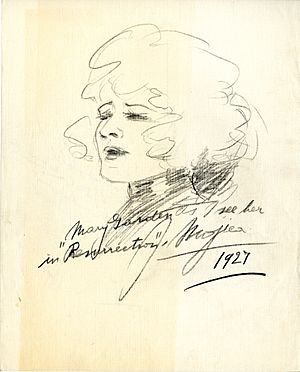
Even though she was director for only one year, she helped produce the first performance of Prokofiev's The Love for Three Oranges. During this time, she also appeared in two silent films made by Samuel Goldwyn. These were Thais (1917) and The Splendid Sinner (1918). During World War I, she received awards from the French and Serbian governments. She was also made a knight of the Légion d'Honneur in 1921.
In 1922, Mary Garden became the director of the new Chicago Civic Opera. She also continued to perform roles there until 1931. She sang in many important performances, including some first shows in the United States. In 1930, she sang in the first performance of Hamilton Forrest's Camille. In 1931, Mary Garden sang her last role with the Chicago Civic Opera, which was Carmen.
Mary Garden retired from the opera stage in 1934. Her last performance was in Risurrezione in Paris. After retiring, she worked as a talent scout for MGM movie studio. She also gave talks and recitals, mostly about the life and music of Claude Debussy. She continued doing this until 1949.
Mary Garden always encouraged young singers. She even secretly paid for some of them to get training. After she retired, she kept supporting young artists by giving master classes. She often let aspiring artists attend for free. She also had her own voice studio in Chicago. One of her students was the soprano Jean Tennyson. Jean Tennyson later used her wealth to help young singers study French opera with Mary Garden.
Later Life and Legacy
Mary Garden was known for her strong personality and always knowing what she wanted. She sometimes had disagreements with other performers, but she usually came out on top. She eventually took control of the Chicago Opera. She was very good at getting attention for herself.
Her autobiography, Mary Garden's Story (1951), tells many interesting tales from her life.
Scottish Opera chose to perform Pelléas et Mélisande in their first season in 1962. This was to celebrate 100 years since Debussy's birth and 60 years since the opera first premiered. Mary Garden was invited to attend, but she was in the hospital after a fall and could not make it.
Mary Garden passed away in Inverurie, Scotland, near Aberdeen. She had lived there for the last 30 years of her life. There is an award for opera singing at the Aberdeen International Youth Festival named after her. There is also a small memorial garden in Aberdeen dedicated to her.
Recordings and Films
Mary Garden made about 40 gramophone records between 1903 and 1929. She recorded for companies like G & T, Columbia, and Victor. These recordings are still available and are important for people who study old music. Mary Garden herself was often not happy with how her voice sounded on these recordings. Four special recordings she made in 1904 were with Claude Debussy playing the piano.
She also appeared in two silent films: Thais (1917) and The Splendid Sinner (1918). Since these were silent films, she couldn't sing in them. Her acting in these films was not as well-received as her singing. In the 1930s, Mary Garden also appeared on Cecil B. DeMille's Lux Radio Theater.
See also
 In Spanish: Mary Garden para niños
In Spanish: Mary Garden para niños


